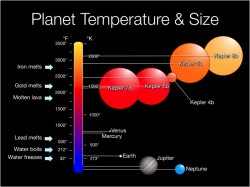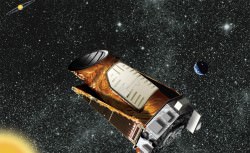We hear about discoveries of exoplanets every day. So how long will it take us to find another planet like Earth?
Back in the olden days, astronomers could only guess if there were planets orbiting other stars.
These were the days when we had to wait at the bank to pay our bills, nobody carried computers in their pockets and those computers gave direct connections to everyone else’s pockets because pocket connectivity is highly important, school was uphill both ways, the number 6 was brand new, we recorded images on thin sheets of transparent plastic, 5 bees were worth a quarter and I had an onion tied to my belt, as was the style at the time.
With the discovery of a mega Jupiter-sized world orbiting the star 51 Pegasi in 1995, the floodgates opened up. In the years that followed, dozens more planets were discovered. Then hundreds, and now, we know about thousands orbiting other stars.
The bad news is we can’t get to any of them. The good news is most of these worlds suck. You don’t want any part of them. For starters their wifi is terrible.
Consider Kepler-70b. This world orbits its star 4 times in a 24 hour period. This means it’s super close, and a great place to really quickly win all the human torch cosplay competitions. The surface temperature is a completely unreasonable 7200 Kelvin, hotter than the surface temperature of the Sun.
There’s the planets orbiting pulsar PSR B1257+12, a millisecond pulsar in the constellation of Virgo. As they whip around their exotic host, they’re bathed in intense radiation. Which is generally considered bad for creatures who need functioning organs.
Perhaps HD 106906 b, orbiting its star 650 times more distantly than we orbit the Sun. You’d spend every second of your short life on that planet inventing new words for cold. And then you’d die. Cold.
Imagine a world that orbits a star like our Sun. A world made of about an Earth’s worth of rocky material that you could stand on, at just the right distance from its star that water can exist as a liquid.
This is what astronomers search for, the tri-wizard cup of extrasolar planetary research. Earth 2? Terra Nova? The Gaia part le deux.
Here’s the exciting part. Astronomers have found each of these characteristics in a planet, but never all together. They’ve found plenty of stars similar to our Sun, with planets orbiting them. In fact, the star HD 10180 is incredibly similar to the Sun, and astronomers have discovered 9 planets orbiting it so far. Which does have a familiar ring to it. No word so far on which ones are about to be demoted to dwarf planets.

They’ve found planets roughly the same mass as the Earth. Kepler-89, with 98% the mass of the Earth. So close! Sadly, it’s way too close to its parent hydrogen furnace to be habitable.
They’ve found planets in the habitable zone. Here on Earth, the global average temperature is -18 degrees C. Sounds cold, but the wintery nights in Antarctica absolutely wreck our GPA.
The closest analog discovered is Kepler-22b, with a global average temperature of -11C. So, it should feel downright balmy. Except, it’s about 2.4 times bigger than Earth and orbits a nasty red dwarf star.
Astronomers have even matched up two criteria at the same time. Earth-sized world orbiting around a Sun-like star, but it’s hellishly hot. Wrong flavor star but with the right temperature and size, it’s a veritable tic tac toe board of near wins.
So far, there hasn’t been a single extrasolar planet discovered that meets all three criteria. An Earth-sized world, orbiting a Sun-like star inside the habitable zone where liquid water could be present.
Astronomers were hoping that NASA’s Kepler spacecraft would have been the first to discover Earth 2.0. It had already turned up thousands of planets, including many of the ones I’ve already mentioned.

Sadly, just a few years into the mission, it lost too many reaction wheels, which allow the spacecraft to change direction. It wasn’t able to make enough observations to help confirm a true Earth 2.0. Kepler is still searching for planets, but with a reduced ability to point, it’s only looking at red dwarf stars.
Don’t worry, NASA’s Transiting Exoplanet Survey Satellite will launch in 2017, and will survey a region of the sky 400 times larger than Kepler did. It should turn up thousands of planets, Earth-sized and larger.
Once we actually find New Terra, things get really interesting. Astronomers will search those planets for life. I know it sounds almost impossible to see life from this distance, but astronomers know that if they can analyze the atmosphere of these worlds, they can detect life flourishing there.
They might even be able to detect the pollution from their alien cars and heavy industry, contributing to their CO2 levels, and learn we’re not so different after all. Even if they’re icky bug people.
At the time I’m recording this video, no analog Earth planet has been discovered so far. But it’s just a matter of time. In the next few decades astronomers are going to find that first Earth 2.0, and then dozens, then hundreds, and even figure out which ones have life on them.
It’s a great time to be alive. Place your bets. Predict the date astronomers announce that we’ll find Earth 2.0. Put your guess into the comments below.


My guess is the first Earth 2.0 will be discovered sometime in mid 2018, a little less than a year after the launch of T.E.S.S. The big news will come a year or so later with the confirmation of organic life on another world. With all the stars and planets in existence, it seems illogical we’d be the only planet with life. Whatever or whoever created the Universe and life on Earth would be the same entity that created life elsewhere in the Universe. It stands to reason life on another Earth-like planet would resemble at least some of the species of life here on Earth. More of my views on this are available here. http://www.amazon.com/Aliens-UFOs-Rick-Bennette-ebook/dp/B00CKZGL6K
Kepler has found how many exoplanets? And that survey only covered 0.25% of the sky!
I was out last night with my 12 1/2″ Newtonian.. cruising the star clouds of Cygus near Kepler’s survey, but in an area with even more stars. Am I alone(?) in that when I see those innumerable concentrations of stars… I am emotionally overwhelmed by the beauty and silent splendor, and can spend hours just ‘cruising’ the neighborhood…
Dear Fraser, you disappoint me, mate! No doubt the scientific community is working very hard to locate that perfect earth twin. That’s no reason to ignore alternative possibilities! What’s wrong with Nibiru? It’s proven, it’s massive, it’s full of people (or, peoploids – if you prefer). That it doesn’t conform with the laws of physics should not matter at all! Haven’t you heard about gift horses and dental examinations? Anyway, I feel the laws of physics are overrated. Newton framed them one cold evening, filled with much more Guinness than he was accustomed to.
I wish you, and others like you, would accord due respect to the Nibiru angle. After all, that’s where our saviors (or killers – the jury’s out still) are gonna come from!
Your form of satire is hilarious… if that’s what it is? Don’t you know the Nibiruians are running the UN? our governments and the post office too! Get a clue! and remember… Those who do not pay attention to history are doomed to repeat it! aka the famous Orsen Wells broadcast of, ‘The War of the Worlds’.
I would think there are additional essential criteria, which should at least include a strong electromagnetic field like earth’s to protect the planet from radiation and solar winds. That requires an iron core, which is very unlikely to form. A fairly stable rotational spin and solar rotation also seem like essential criteria. You don’t want to be facing the sun or on the dark side for too long. In fact, some would even argue a large moon is required to stabilize the planet. In short, the conditions necessary to create complex life is likely to be a lot more complex than we currently believe — like most things!
Keep looking. We will find it when we find it;)